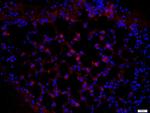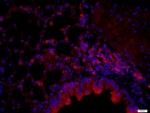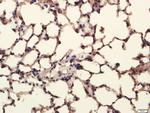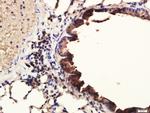Search Thermo Fisher Scientific
FIGURE: 1 / 4
Pan Cytokeratin/p-CK Antibody (BS-10403R) in IHC (P)




Product Details
BS-10403R
Species Reactivity
Host/Isotype
Class
Type
Immunogen
Conjugate
Form
Concentration
Purification
Storage buffer
Contains
Storage conditions
Shipping conditions
Target Information
Cytokeratin pan is part of a subfamily of intermediate filament proteins that are characterized by remarkable biochemical diversity, and represented in human epithelial tissues by at least 20 different polypeptides. Cytokeratins range in molecular weight between 40 kDa- 68 kDa, and an isoelectric pH between 4.9-7.8. The individual human cytokeratins are numbered 1 to 20. The various epithelia in the human body usually express cytokeratins which are not only characteristic of the type of epithelium, but also related to the degree of maturation or differentiation within an epithelium. Cytokeratin subtype expression patterns are used to an increasing extent in the distinction of different types of epithelial malignancies. The cytokeratin antibodies are not only of assistance in the differential diagnosis of tumors using immunohistochemistry on tissue sections, but are also a useful tool in cytopathology and flow cytometric assays. The composition of cytokeratin pairs vary with the epithelial cell type, stage of differentiation, cellular growth environment, and disease state. Many studies have shown the usefulness of keratins as markers in cancer research and tumor diagnosis.
For Research Use Only. Not for use in diagnostic procedures. Not for resale without express authorization.
References (0)
Bioinformatics
Protein Aliases: 40-kDa keratin intermediate filament; 56 kDa cytokeratin; Acidic Cytokeratin; Cell proliferation-inducing gene 46 protein; CK-10; CK-14; CK-15; CK-16; CK-18; CK-19; CK-9; cytokeratin 10; cytokeratin 14; cytokeratin 15; cytokeratin 16; cytokeratin 18; cytokeratin 19; cytokeratin 9; Cytokeratin endo B; Cytokeratin-10; Cytokeratin-14; Cytokeratin-15; Cytokeratin-16; Cytokeratin-18; Cytokeratin-19; Cytokeratin-9; Endo B; epidermal keratin 10; epidermolysis bullosa simplex, Dowling-Meara, Koebner; focal non-epidermolytic palmoplantar keratoderma; HMWCK; intermediate filament protein; K10; K14; K15; K16; K18; K19; K9; keratin 10, type I; keratin 14 (epidermolysis bullosa simplex, Dowling-Meara, Koebner); keratin 14, type I; keratin 15, type I; keratin 16, type I; keratin 18, type I; keratin 19, type I; keratin 9 (epidermolytic palmoplantar keratoderma); keratin 9, type I; keratin complex 1, acidic, gene 10; keratin complex 1, acidic, gene 14; keratin complex 1, acidic, gene 15; keratin complex 1, acidic, gene 16; keratin complex 1, acidic, gene 18; keratin complex 1, acidic, gene 19; keratin complex 1, acidic, gene 9; Keratin D; keratin intermediate filament 16a; keratin intermediate filament 16b; Keratin, type I cytoskeletal 10; Keratin, type I cytoskeletal 14; Keratin, type I cytoskeletal 15; Keratin, type I cytoskeletal 16; Keratin, type I cytoskeletal 18; Keratin, type I cytoskeletal 19; Keratin, type I cytoskeletal 59 kDa; Keratin, type I cytoskeletal 9; keratin, type I, 40-kd; Keratin-10; Keratin-14; Keratin-15; keratin-15, basic; keratin-15, beta; Keratin-16; Keratin-18; Keratin-19; Keratin-9; krt10 {ECO:0000250|UniProtKB:P13645}; krt15 {ECO:0000250|UniProtKB:P19012}; krt18 {ECO:0000250|UniProtKB:P05783}; krt9; pan keratin; pankeratin; Spermatid perinuclear ring manchette protein K9; suprabasal cytokeratin 10; type I cytoskeletal 15; type I cytoskeletal 9; type I keratin KA10; Type I keratin Ka14; Type I keratin Ka15; type I keratin KA16; Type I keratin Ka19
Gene Aliases: AI324768; AI528832; AI626930; AI663979; BCIE; BIE; CK-18; CK-9; CK10; CK14; CK15; CK16; CK18; CK19; CYK18; D130054E02Rik; EBS3; EBS4; EHK; EndoC; EPPK; FNEPPK; K10; K14; K15; K16; K18; K19; K1C1; K1CO; K1CP; K1CS; K9; Ka10; Ka14; Ka15; Ka16; Ka19; Kerd; KPP; Krt-1.10; Krt-1.14; Krt-1.19; Krt1-10; Krt1-14; Krt1-15; Krt1-16; Krt1-18; Krt1-19; Krt1-9; KRT10; KRT14; KRT15; KRT16; KRT16A; KRT18; KRT19; KRT9; KRTB; NEPPK; NFJ; PC1; PIG46
UniProt ID: (Human) P13645, (Human) P02533, (Human) P19012, (Human) P08779, (Human) P05783, (Human) P08727, (Human) P35527, (Mouse) P02535, (Mouse) Q61781, (Rat) Q6IFV1, (Mouse) Q61414, (Rat) Q6IFV3, (Mouse) Q9Z2K1, (Rat) Q5BJY9, (Mouse) P05784, (Mouse) P19001, (Rat) Q63279, (Rat) Q8CIS9, (Mouse) Q6RHW0
Entrez Gene ID: (Human) 3858, (Human) 3861, (Human) 3866, (Human) 3868, (Human) 3875, (Human) 3880, (Human) 3857, (Mouse) 16661, (Rat) 450225, (Mouse) 16664, (Rat) 287701, (Mouse) 16665, (Rat) 287700, (Mouse) 16666, (Rat) 303530, (Rat) 294853, (Mouse) 16668, (Mouse) 16669, (Rat) 360626, (Rat) 266717, (Mouse) 107656

Performance Guarantee
If an Invitrogen™ antibody doesn't perform as described on our website or datasheet,we'll replace the product at no cost to you, or provide you with a credit for a future purchase.*
Learn more
We're here to help
Get expert recommendations for common problems or connect directly with an on staff expert for technical assistance related to applications, equipment and general product use.
Contact tech support
